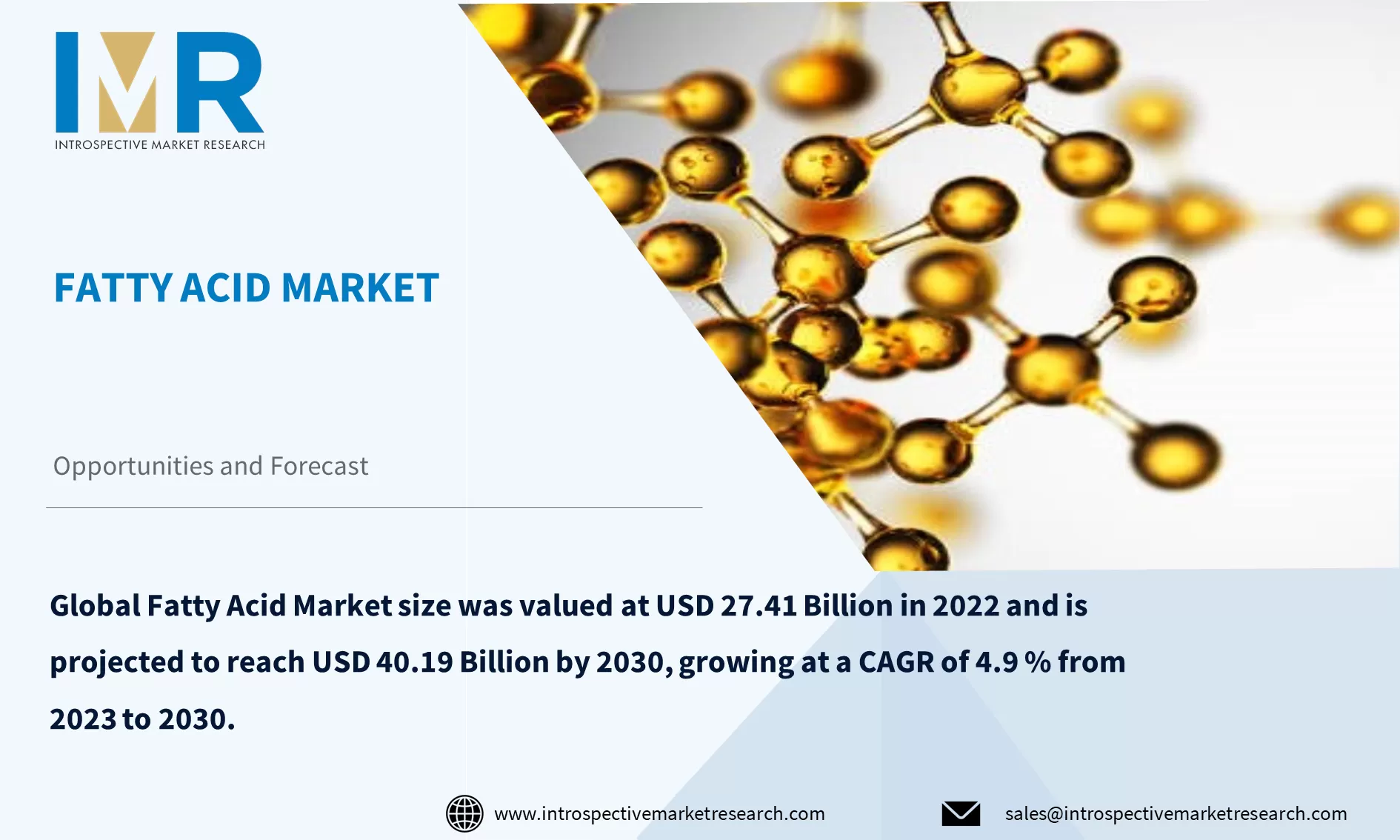
Global Fatty Acid Market size was valued at USD 27.41 Billion in 2022 and is projected to reach USD 40.19 Billion by 2030, growing at a CAGR of 4.9 % from 2023 to 2030.
Triglycerides and phospholipids contain the long hydrocarbon chains known as fatty acids. Based on the number of bonds between the carbon atoms, fatty acids can be divided into saturated, monounsaturated, and poly-unsaturated types. Saturated fatty acids are defined as having no double bonds and a linear structure. Monounsaturated fatty acids are defined as having a single double bond, while polyunsaturated fatty acids have multiple double bonds. Essential fatty acids are obtained from a variety of external sources, including plants, vegetable oils, nuts and seeds, animal fats, and others because they cannot be synthesized by the human body.
Top Key Players for Fatty Acid Market:
BASF SE (Germany), Akzo Nobel N.V (Netherlands), Ashland Inc. (US), Wujiang Jinyu Lanolin Co. (China), Vantage Oleochemicals (US), Aker BioMarine AS (Norway), Ferro Corporation (US), Oleon N.V. (Belgium), Arizona Chemicals (US), Eastman Chemical Company (US), Colgate-Palmolive Ltd (India), Godrej Industries (India), Ferro Corporation (US), Longyan Zhuoyue New Energy Co. Ltd. (China), and Eastman Chemical Corporation (US), and Other Major Players
Market Dynamics and Factors for Fatty Acid Market:
Drivers:
Increase Awareness Regarding Personal Hygiene And Cleaning
Increasing awareness regarding personal hygiene and cleaning practices is of utmost importance, especially in the context of public health and preventing the spread of infectious diseases. Personal hygiene refers to maintaining cleanliness and adopting healthy habits to safeguard oneself and others from harmful germs and pathogens. Fatty acids, with their versatile properties and applications in cleaning products, can play a significant role in enhancing the effectiveness of hygiene practices. Effective personal hygiene starts with simple yet powerful habits, such as regular handwashing with soap and water. Clean hands are essential for preventing the transmission of viruses and bacteria that can be picked up from various surfaces, including doorknobs, handrails, and shared objects. Proper hand hygiene, especially before handling food and after using the restroom, is crucial for reducing the risk of infections.
Opportunities:
Increasing Pharmaceuticals And Therapeutics Uses
Over the years, there has been a significant increase in research focused on the potential health benefits of fatty acids. Studies have explored their impact on cardiovascular health, brain function, inflammation, and various other health conditions. As more evidence emerges supporting the positive effects of fatty acids, pharmaceutical companies have an opportunity to develop targeted medications and therapeutic solutions based on this research.
Consumers are increasingly seeking natural and plant-based alternatives to synthetic drugs and pharmaceuticals. Fatty acids, being naturally occurring compounds found in various food sources, align well with this growing demand for natural and nutraceutical solutions. This creates opportunities for pharmaceutical companies to develop fatty acid-based products that appeal to health-conscious consumers.
Segmentation Analysis of the Fatty Acid Market:
- By Source, Plant-based fats and oils can be a major component of the product (e.g., vegan smoked salmon) or a minor additive depending on the amount used. Fats and oils commonly incorporated into plant-based imitation fish products included canola oil, sunflower oil, and flaxseed oil. Fats are an essential component that improves overall palatability and contributes to the flavor, tenderness, and mouthfeel, and give succulence to products that can otherwise be dry, Thus the plant-based fatty oil dominates the market during the forecast period.
- By Type of Technology, in 2022, polyunsaturated fatty acids saw major growth in the fatty acid market. The sector is expanding as a result of factors like an increase in cardiovascular disorders, growing public knowledge of the health advantages of PUFAs, and rising consumption of goods containing omega-3 fatty acids.
Regional Analysis of the Fatty Acid Market:
Asia Pacific is home to a significant portion of the world's population, including countries like China and India with massive consumer bases. The large and growing population in this region drives the demand for various products, including food, beverages, personal care items, and pharmaceuticals, all of which utilize fatty acids as key ingredients. The rising middle-class population in Asia Pacific countries has led to increased disposable income, resulting in higher consumer spending on various products, including those containing fatty acids. As people become more health-conscious and seek products with added nutritional value, the demand for functional foods and dietary supplements enriched with fatty acids has grown significantly.
Key Industry Development:
- In August 2022, a Seraphina Therapeutics study discovered a new fatty acid, eyeing the C15:0 supplement formulation. C15:0 is utilized by human bodies for making the 2nd-ever discovered full-acting endocannabinoid, known as PDC.
- In November 2022, Epax launched a long-chain monounsaturated fatty acid ingredient: Cetoleic 10. This ingredient consists of cetoleic acid, an omega-11 marine lipid, and gondoic acid (omega-9). The extract is extracted from North Atlantic fish, which is lower in docosahexaenoic acid (DHA) and eicosapentaenoic acid (EPA).





